TESCO Report: Analyzing Team Dynamics and Organizational Behavior
VerifiedAdded on 2021/02/20
|8
|2274
|63
Report
AI Summary
This report examines organizational behavior within TESCO, a major retail company, focusing on the dynamics of effective and ineffective teams. It defines teams, highlighting the importance of collaboration and different team types, such as functional, cross-functional, self-managed, and virtual teams. The report contrasts effective teams, which exhibit clear communication and goal orientation, with ineffective teams, characterized by lack of unity and poor decision-making. It then applies Tuckman's team development model to TESCO, outlining the stages of forming, storming, norming, and performing. Furthermore, the report explores key organizational behavior concepts, including path-goal theory, emphasizing leadership styles and contingency factors, and Maslow's hierarchy of needs, analyzing how TESCO can address employee needs at various levels to enhance motivation and job satisfaction. The report concludes by emphasizing the critical role of organizational behavior in achieving business success through effective teams and motivational strategies.
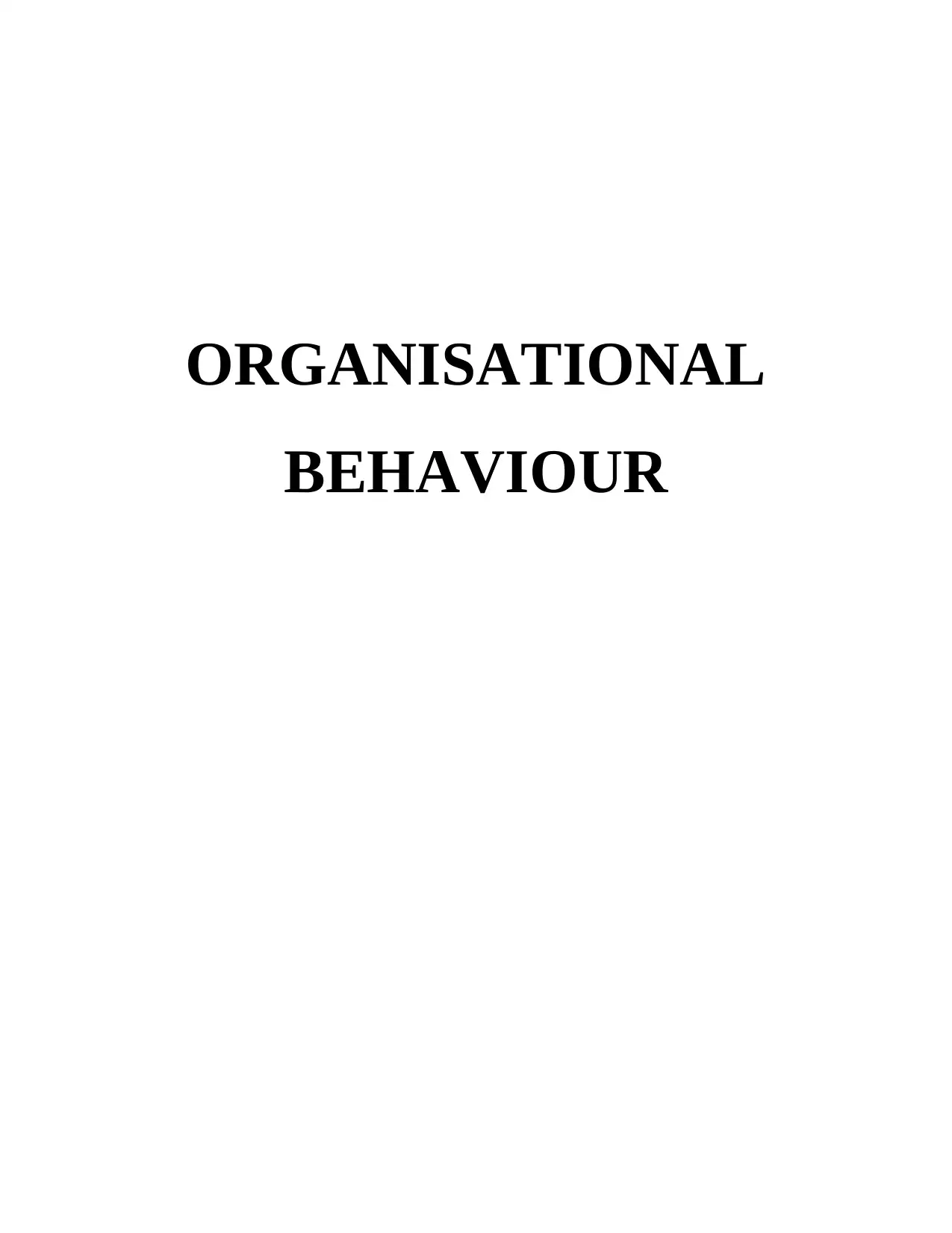
ORGANISATIONAL
BEHAVIOUR
BEHAVIOUR
Paraphrase This Document
Need a fresh take? Get an instant paraphrase of this document with our AI Paraphraser
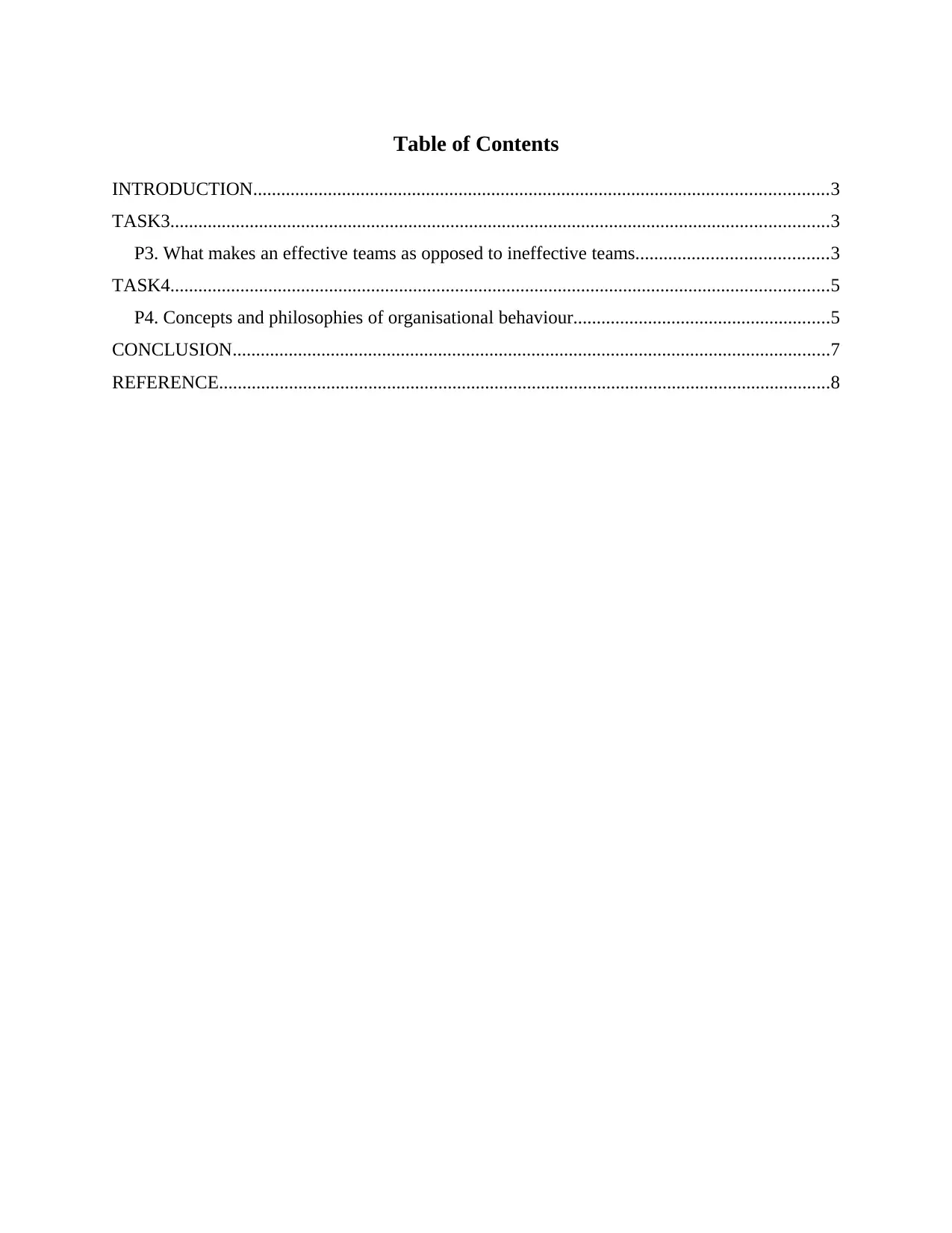
Table of Contents
INTRODUCTION...........................................................................................................................3
TASK3.............................................................................................................................................3
P3. What makes an effective teams as opposed to ineffective teams.........................................3
TASK4.............................................................................................................................................5
P4. Concepts and philosophies of organisational behaviour.......................................................5
CONCLUSION................................................................................................................................7
REFERENCE...................................................................................................................................8
INTRODUCTION...........................................................................................................................3
TASK3.............................................................................................................................................3
P3. What makes an effective teams as opposed to ineffective teams.........................................3
TASK4.............................................................................................................................................5
P4. Concepts and philosophies of organisational behaviour.......................................................5
CONCLUSION................................................................................................................................7
REFERENCE...................................................................................................................................8
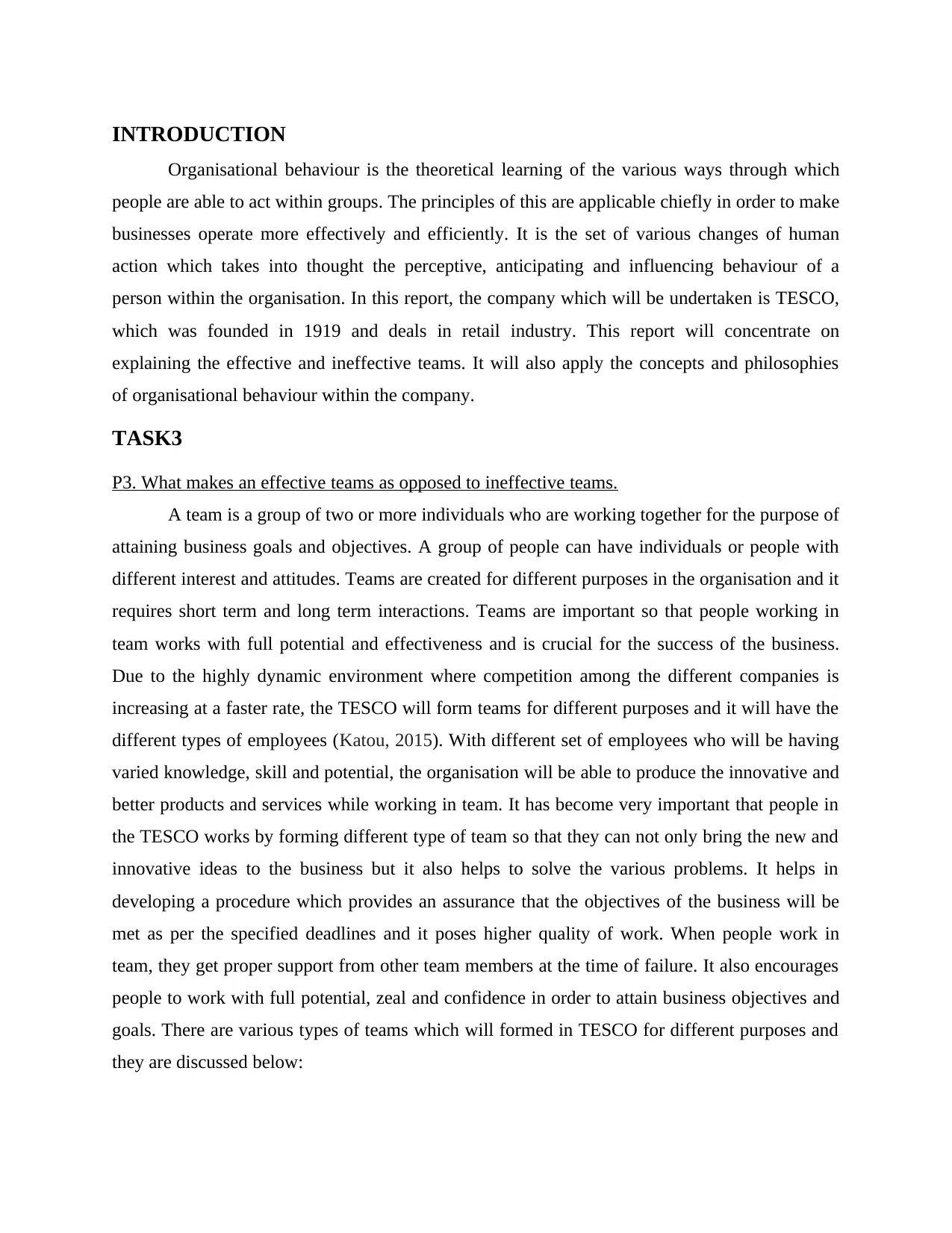
INTRODUCTION
Organisational behaviour is the theoretical learning of the various ways through which
people are able to act within groups. The principles of this are applicable chiefly in order to make
businesses operate more effectively and efficiently. It is the set of various changes of human
action which takes into thought the perceptive, anticipating and influencing behaviour of a
person within the organisation. In this report, the company which will be undertaken is TESCO,
which was founded in 1919 and deals in retail industry. This report will concentrate on
explaining the effective and ineffective teams. It will also apply the concepts and philosophies
of organisational behaviour within the company.
TASK3
P3. What makes an effective teams as opposed to ineffective teams.
A team is a group of two or more individuals who are working together for the purpose of
attaining business goals and objectives. A group of people can have individuals or people with
different interest and attitudes. Teams are created for different purposes in the organisation and it
requires short term and long term interactions. Teams are important so that people working in
team works with full potential and effectiveness and is crucial for the success of the business.
Due to the highly dynamic environment where competition among the different companies is
increasing at a faster rate, the TESCO will form teams for different purposes and it will have the
different types of employees (Katou, 2015). With different set of employees who will be having
varied knowledge, skill and potential, the organisation will be able to produce the innovative and
better products and services while working in team. It has become very important that people in
the TESCO works by forming different type of team so that they can not only bring the new and
innovative ideas to the business but it also helps to solve the various problems. It helps in
developing a procedure which provides an assurance that the objectives of the business will be
met as per the specified deadlines and it poses higher quality of work. When people work in
team, they get proper support from other team members at the time of failure. It also encourages
people to work with full potential, zeal and confidence in order to attain business objectives and
goals. There are various types of teams which will formed in TESCO for different purposes and
they are discussed below:
Organisational behaviour is the theoretical learning of the various ways through which
people are able to act within groups. The principles of this are applicable chiefly in order to make
businesses operate more effectively and efficiently. It is the set of various changes of human
action which takes into thought the perceptive, anticipating and influencing behaviour of a
person within the organisation. In this report, the company which will be undertaken is TESCO,
which was founded in 1919 and deals in retail industry. This report will concentrate on
explaining the effective and ineffective teams. It will also apply the concepts and philosophies
of organisational behaviour within the company.
TASK3
P3. What makes an effective teams as opposed to ineffective teams.
A team is a group of two or more individuals who are working together for the purpose of
attaining business goals and objectives. A group of people can have individuals or people with
different interest and attitudes. Teams are created for different purposes in the organisation and it
requires short term and long term interactions. Teams are important so that people working in
team works with full potential and effectiveness and is crucial for the success of the business.
Due to the highly dynamic environment where competition among the different companies is
increasing at a faster rate, the TESCO will form teams for different purposes and it will have the
different types of employees (Katou, 2015). With different set of employees who will be having
varied knowledge, skill and potential, the organisation will be able to produce the innovative and
better products and services while working in team. It has become very important that people in
the TESCO works by forming different type of team so that they can not only bring the new and
innovative ideas to the business but it also helps to solve the various problems. It helps in
developing a procedure which provides an assurance that the objectives of the business will be
met as per the specified deadlines and it poses higher quality of work. When people work in
team, they get proper support from other team members at the time of failure. It also encourages
people to work with full potential, zeal and confidence in order to attain business objectives and
goals. There are various types of teams which will formed in TESCO for different purposes and
they are discussed below:
⊘ This is a preview!⊘
Do you want full access?
Subscribe today to unlock all pages.

Trusted by 1+ million students worldwide
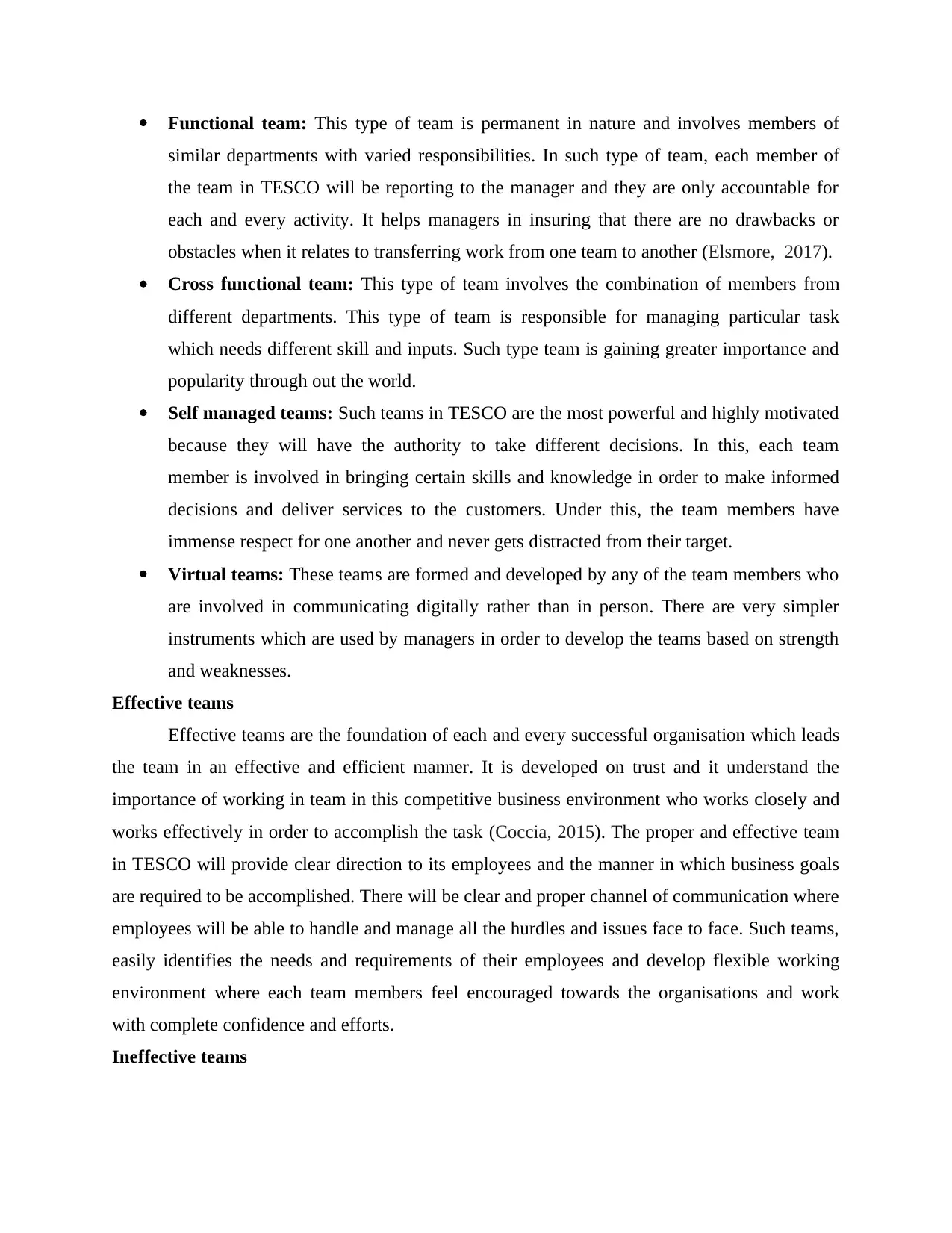
Functional team: This type of team is permanent in nature and involves members of
similar departments with varied responsibilities. In such type of team, each member of
the team in TESCO will be reporting to the manager and they are only accountable for
each and every activity. It helps managers in insuring that there are no drawbacks or
obstacles when it relates to transferring work from one team to another (Elsmore, 2017).
Cross functional team: This type of team involves the combination of members from
different departments. This type of team is responsible for managing particular task
which needs different skill and inputs. Such type team is gaining greater importance and
popularity through out the world.
Self managed teams: Such teams in TESCO are the most powerful and highly motivated
because they will have the authority to take different decisions. In this, each team
member is involved in bringing certain skills and knowledge in order to make informed
decisions and deliver services to the customers. Under this, the team members have
immense respect for one another and never gets distracted from their target.
Virtual teams: These teams are formed and developed by any of the team members who
are involved in communicating digitally rather than in person. There are very simpler
instruments which are used by managers in order to develop the teams based on strength
and weaknesses.
Effective teams
Effective teams are the foundation of each and every successful organisation which leads
the team in an effective and efficient manner. It is developed on trust and it understand the
importance of working in team in this competitive business environment who works closely and
works effectively in order to accomplish the task (Coccia, 2015). The proper and effective team
in TESCO will provide clear direction to its employees and the manner in which business goals
are required to be accomplished. There will be clear and proper channel of communication where
employees will be able to handle and manage all the hurdles and issues face to face. Such teams,
easily identifies the needs and requirements of their employees and develop flexible working
environment where each team members feel encouraged towards the organisations and work
with complete confidence and efforts.
Ineffective teams
similar departments with varied responsibilities. In such type of team, each member of
the team in TESCO will be reporting to the manager and they are only accountable for
each and every activity. It helps managers in insuring that there are no drawbacks or
obstacles when it relates to transferring work from one team to another (Elsmore, 2017).
Cross functional team: This type of team involves the combination of members from
different departments. This type of team is responsible for managing particular task
which needs different skill and inputs. Such type team is gaining greater importance and
popularity through out the world.
Self managed teams: Such teams in TESCO are the most powerful and highly motivated
because they will have the authority to take different decisions. In this, each team
member is involved in bringing certain skills and knowledge in order to make informed
decisions and deliver services to the customers. Under this, the team members have
immense respect for one another and never gets distracted from their target.
Virtual teams: These teams are formed and developed by any of the team members who
are involved in communicating digitally rather than in person. There are very simpler
instruments which are used by managers in order to develop the teams based on strength
and weaknesses.
Effective teams
Effective teams are the foundation of each and every successful organisation which leads
the team in an effective and efficient manner. It is developed on trust and it understand the
importance of working in team in this competitive business environment who works closely and
works effectively in order to accomplish the task (Coccia, 2015). The proper and effective team
in TESCO will provide clear direction to its employees and the manner in which business goals
are required to be accomplished. There will be clear and proper channel of communication where
employees will be able to handle and manage all the hurdles and issues face to face. Such teams,
easily identifies the needs and requirements of their employees and develop flexible working
environment where each team members feel encouraged towards the organisations and work
with complete confidence and efforts.
Ineffective teams
Paraphrase This Document
Need a fresh take? Get an instant paraphrase of this document with our AI Paraphraser
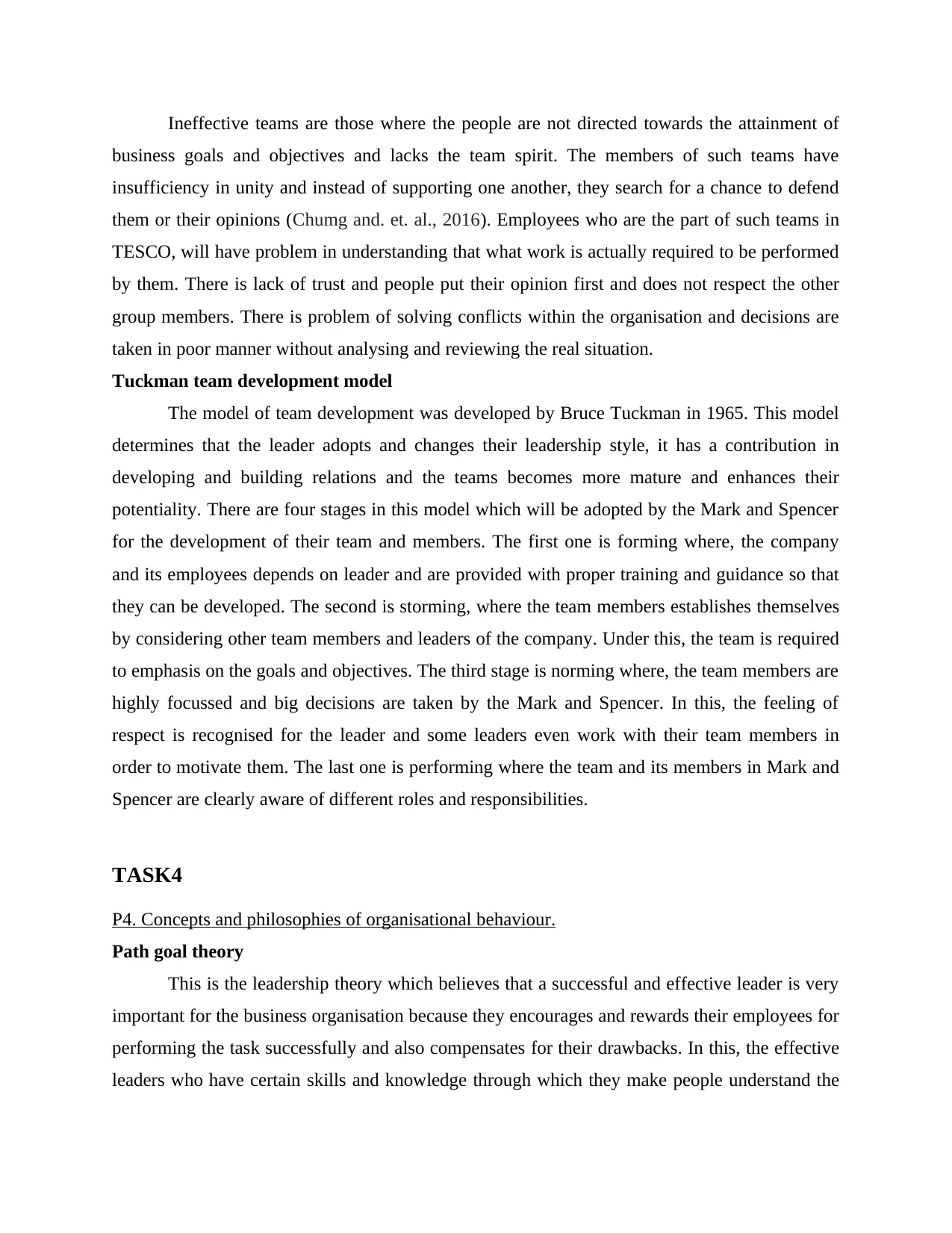
Ineffective teams are those where the people are not directed towards the attainment of
business goals and objectives and lacks the team spirit. The members of such teams have
insufficiency in unity and instead of supporting one another, they search for a chance to defend
them or their opinions (Chumg and. et. al., 2016). Employees who are the part of such teams in
TESCO, will have problem in understanding that what work is actually required to be performed
by them. There is lack of trust and people put their opinion first and does not respect the other
group members. There is problem of solving conflicts within the organisation and decisions are
taken in poor manner without analysing and reviewing the real situation.
Tuckman team development model
The model of team development was developed by Bruce Tuckman in 1965. This model
determines that the leader adopts and changes their leadership style, it has a contribution in
developing and building relations and the teams becomes more mature and enhances their
potentiality. There are four stages in this model which will be adopted by the Mark and Spencer
for the development of their team and members. The first one is forming where, the company
and its employees depends on leader and are provided with proper training and guidance so that
they can be developed. The second is storming, where the team members establishes themselves
by considering other team members and leaders of the company. Under this, the team is required
to emphasis on the goals and objectives. The third stage is norming where, the team members are
highly focussed and big decisions are taken by the Mark and Spencer. In this, the feeling of
respect is recognised for the leader and some leaders even work with their team members in
order to motivate them. The last one is performing where the team and its members in Mark and
Spencer are clearly aware of different roles and responsibilities.
TASK4
P4. Concepts and philosophies of organisational behaviour.
Path goal theory
This is the leadership theory which believes that a successful and effective leader is very
important for the business organisation because they encourages and rewards their employees for
performing the task successfully and also compensates for their drawbacks. In this, the effective
leaders who have certain skills and knowledge through which they make people understand the
business goals and objectives and lacks the team spirit. The members of such teams have
insufficiency in unity and instead of supporting one another, they search for a chance to defend
them or their opinions (Chumg and. et. al., 2016). Employees who are the part of such teams in
TESCO, will have problem in understanding that what work is actually required to be performed
by them. There is lack of trust and people put their opinion first and does not respect the other
group members. There is problem of solving conflicts within the organisation and decisions are
taken in poor manner without analysing and reviewing the real situation.
Tuckman team development model
The model of team development was developed by Bruce Tuckman in 1965. This model
determines that the leader adopts and changes their leadership style, it has a contribution in
developing and building relations and the teams becomes more mature and enhances their
potentiality. There are four stages in this model which will be adopted by the Mark and Spencer
for the development of their team and members. The first one is forming where, the company
and its employees depends on leader and are provided with proper training and guidance so that
they can be developed. The second is storming, where the team members establishes themselves
by considering other team members and leaders of the company. Under this, the team is required
to emphasis on the goals and objectives. The third stage is norming where, the team members are
highly focussed and big decisions are taken by the Mark and Spencer. In this, the feeling of
respect is recognised for the leader and some leaders even work with their team members in
order to motivate them. The last one is performing where the team and its members in Mark and
Spencer are clearly aware of different roles and responsibilities.
TASK4
P4. Concepts and philosophies of organisational behaviour.
Path goal theory
This is the leadership theory which believes that a successful and effective leader is very
important for the business organisation because they encourages and rewards their employees for
performing the task successfully and also compensates for their drawbacks. In this, the effective
leaders who have certain skills and knowledge through which they make people understand the
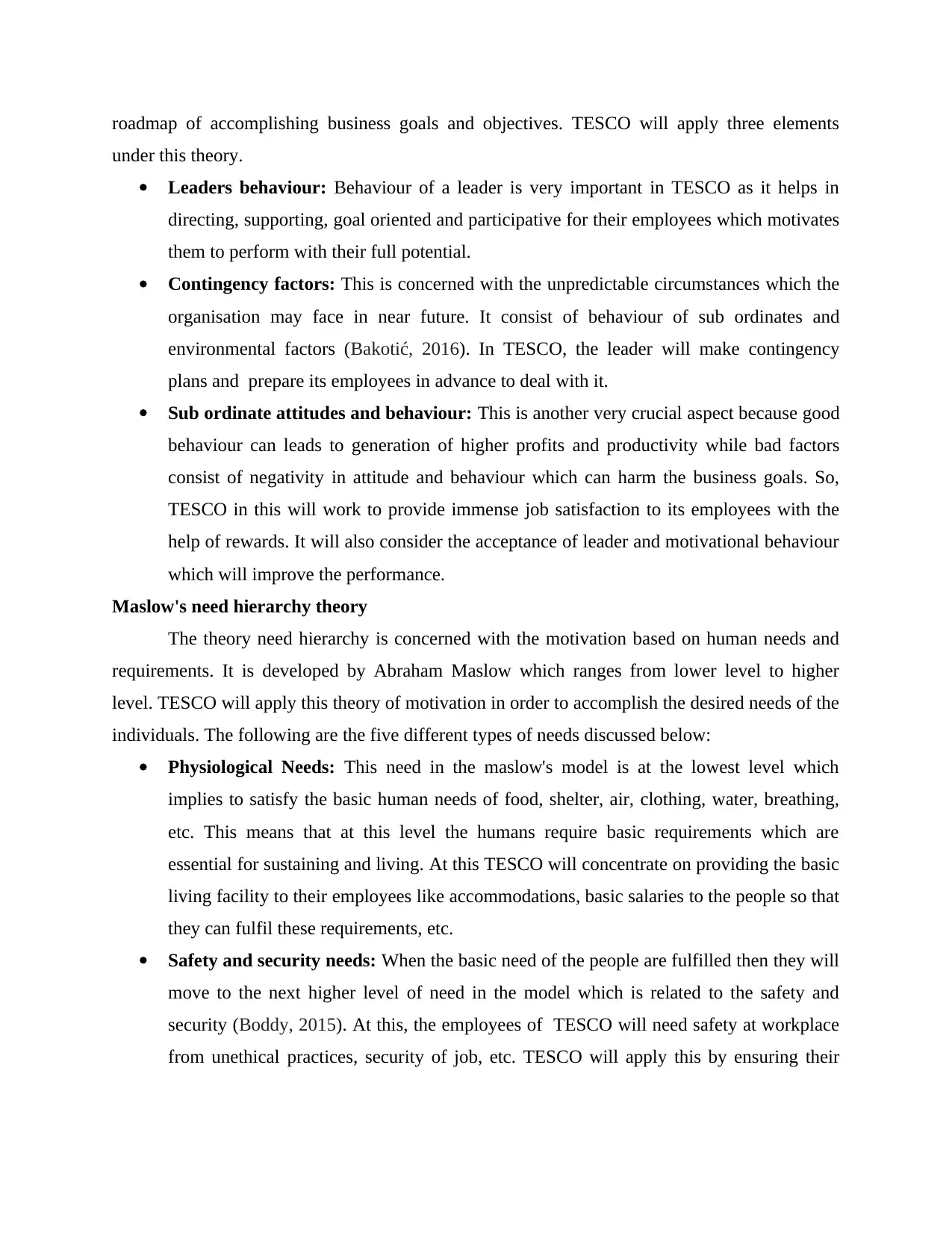
roadmap of accomplishing business goals and objectives. TESCO will apply three elements
under this theory.
Leaders behaviour: Behaviour of a leader is very important in TESCO as it helps in
directing, supporting, goal oriented and participative for their employees which motivates
them to perform with their full potential.
Contingency factors: This is concerned with the unpredictable circumstances which the
organisation may face in near future. It consist of behaviour of sub ordinates and
environmental factors (Bakotić, 2016). In TESCO, the leader will make contingency
plans and prepare its employees in advance to deal with it.
Sub ordinate attitudes and behaviour: This is another very crucial aspect because good
behaviour can leads to generation of higher profits and productivity while bad factors
consist of negativity in attitude and behaviour which can harm the business goals. So,
TESCO in this will work to provide immense job satisfaction to its employees with the
help of rewards. It will also consider the acceptance of leader and motivational behaviour
which will improve the performance.
Maslow's need hierarchy theory
The theory need hierarchy is concerned with the motivation based on human needs and
requirements. It is developed by Abraham Maslow which ranges from lower level to higher
level. TESCO will apply this theory of motivation in order to accomplish the desired needs of the
individuals. The following are the five different types of needs discussed below:
Physiological Needs: This need in the maslow's model is at the lowest level which
implies to satisfy the basic human needs of food, shelter, air, clothing, water, breathing,
etc. This means that at this level the humans require basic requirements which are
essential for sustaining and living. At this TESCO will concentrate on providing the basic
living facility to their employees like accommodations, basic salaries to the people so that
they can fulfil these requirements, etc.
Safety and security needs: When the basic need of the people are fulfilled then they will
move to the next higher level of need in the model which is related to the safety and
security (Boddy, 2015). At this, the employees of TESCO will need safety at workplace
from unethical practices, security of job, etc. TESCO will apply this by ensuring their
under this theory.
Leaders behaviour: Behaviour of a leader is very important in TESCO as it helps in
directing, supporting, goal oriented and participative for their employees which motivates
them to perform with their full potential.
Contingency factors: This is concerned with the unpredictable circumstances which the
organisation may face in near future. It consist of behaviour of sub ordinates and
environmental factors (Bakotić, 2016). In TESCO, the leader will make contingency
plans and prepare its employees in advance to deal with it.
Sub ordinate attitudes and behaviour: This is another very crucial aspect because good
behaviour can leads to generation of higher profits and productivity while bad factors
consist of negativity in attitude and behaviour which can harm the business goals. So,
TESCO in this will work to provide immense job satisfaction to its employees with the
help of rewards. It will also consider the acceptance of leader and motivational behaviour
which will improve the performance.
Maslow's need hierarchy theory
The theory need hierarchy is concerned with the motivation based on human needs and
requirements. It is developed by Abraham Maslow which ranges from lower level to higher
level. TESCO will apply this theory of motivation in order to accomplish the desired needs of the
individuals. The following are the five different types of needs discussed below:
Physiological Needs: This need in the maslow's model is at the lowest level which
implies to satisfy the basic human needs of food, shelter, air, clothing, water, breathing,
etc. This means that at this level the humans require basic requirements which are
essential for sustaining and living. At this TESCO will concentrate on providing the basic
living facility to their employees like accommodations, basic salaries to the people so that
they can fulfil these requirements, etc.
Safety and security needs: When the basic need of the people are fulfilled then they will
move to the next higher level of need in the model which is related to the safety and
security (Boddy, 2015). At this, the employees of TESCO will need safety at workplace
from unethical practices, security of job, etc. TESCO will apply this by ensuring their
⊘ This is a preview!⊘
Do you want full access?
Subscribe today to unlock all pages.

Trusted by 1+ million students worldwide
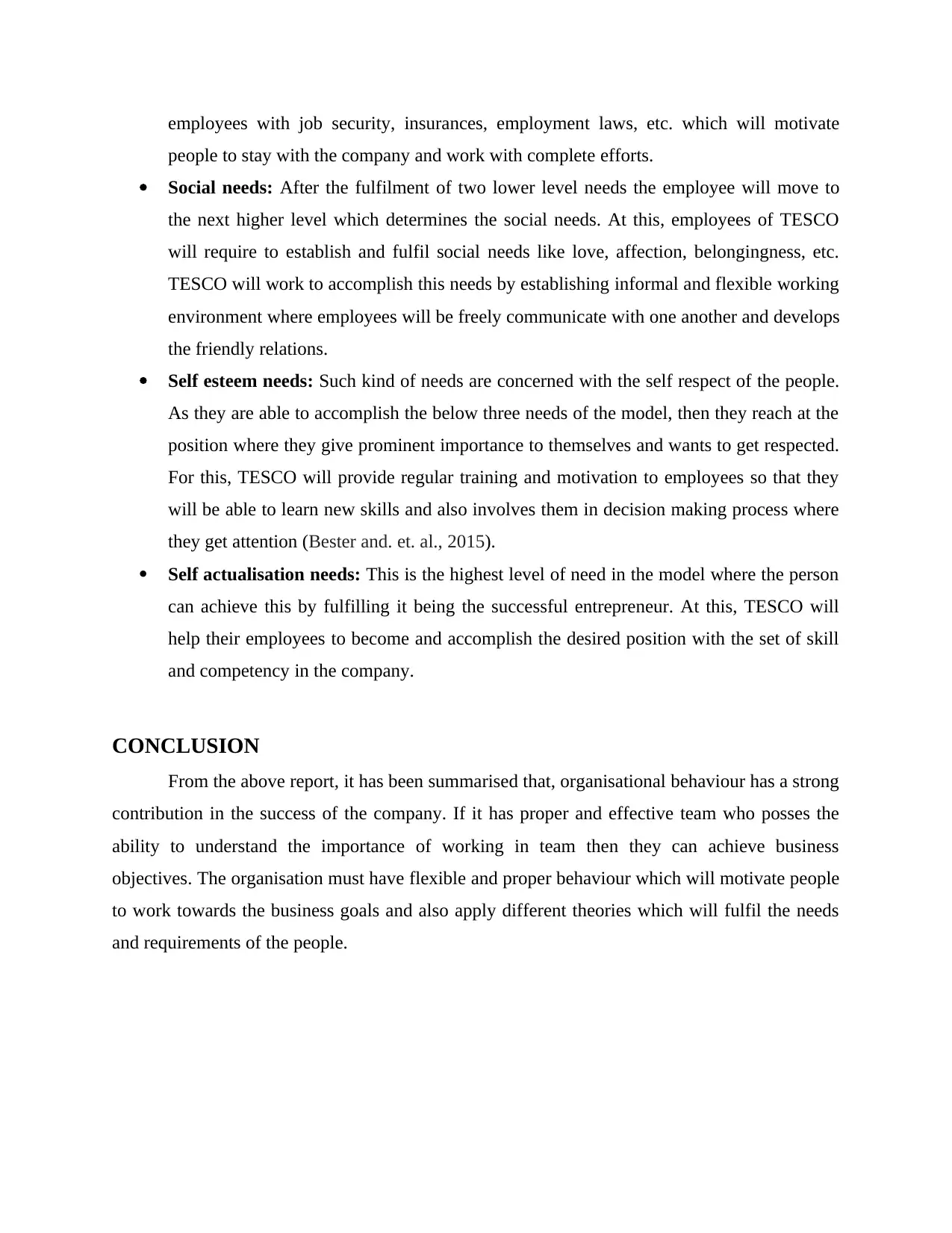
employees with job security, insurances, employment laws, etc. which will motivate
people to stay with the company and work with complete efforts.
Social needs: After the fulfilment of two lower level needs the employee will move to
the next higher level which determines the social needs. At this, employees of TESCO
will require to establish and fulfil social needs like love, affection, belongingness, etc.
TESCO will work to accomplish this needs by establishing informal and flexible working
environment where employees will be freely communicate with one another and develops
the friendly relations.
Self esteem needs: Such kind of needs are concerned with the self respect of the people.
As they are able to accomplish the below three needs of the model, then they reach at the
position where they give prominent importance to themselves and wants to get respected.
For this, TESCO will provide regular training and motivation to employees so that they
will be able to learn new skills and also involves them in decision making process where
they get attention (Bester and. et. al., 2015).
Self actualisation needs: This is the highest level of need in the model where the person
can achieve this by fulfilling it being the successful entrepreneur. At this, TESCO will
help their employees to become and accomplish the desired position with the set of skill
and competency in the company.
CONCLUSION
From the above report, it has been summarised that, organisational behaviour has a strong
contribution in the success of the company. If it has proper and effective team who posses the
ability to understand the importance of working in team then they can achieve business
objectives. The organisation must have flexible and proper behaviour which will motivate people
to work towards the business goals and also apply different theories which will fulfil the needs
and requirements of the people.
people to stay with the company and work with complete efforts.
Social needs: After the fulfilment of two lower level needs the employee will move to
the next higher level which determines the social needs. At this, employees of TESCO
will require to establish and fulfil social needs like love, affection, belongingness, etc.
TESCO will work to accomplish this needs by establishing informal and flexible working
environment where employees will be freely communicate with one another and develops
the friendly relations.
Self esteem needs: Such kind of needs are concerned with the self respect of the people.
As they are able to accomplish the below three needs of the model, then they reach at the
position where they give prominent importance to themselves and wants to get respected.
For this, TESCO will provide regular training and motivation to employees so that they
will be able to learn new skills and also involves them in decision making process where
they get attention (Bester and. et. al., 2015).
Self actualisation needs: This is the highest level of need in the model where the person
can achieve this by fulfilling it being the successful entrepreneur. At this, TESCO will
help their employees to become and accomplish the desired position with the set of skill
and competency in the company.
CONCLUSION
From the above report, it has been summarised that, organisational behaviour has a strong
contribution in the success of the company. If it has proper and effective team who posses the
ability to understand the importance of working in team then they can achieve business
objectives. The organisation must have flexible and proper behaviour which will motivate people
to work towards the business goals and also apply different theories which will fulfil the needs
and requirements of the people.
Paraphrase This Document
Need a fresh take? Get an instant paraphrase of this document with our AI Paraphraser
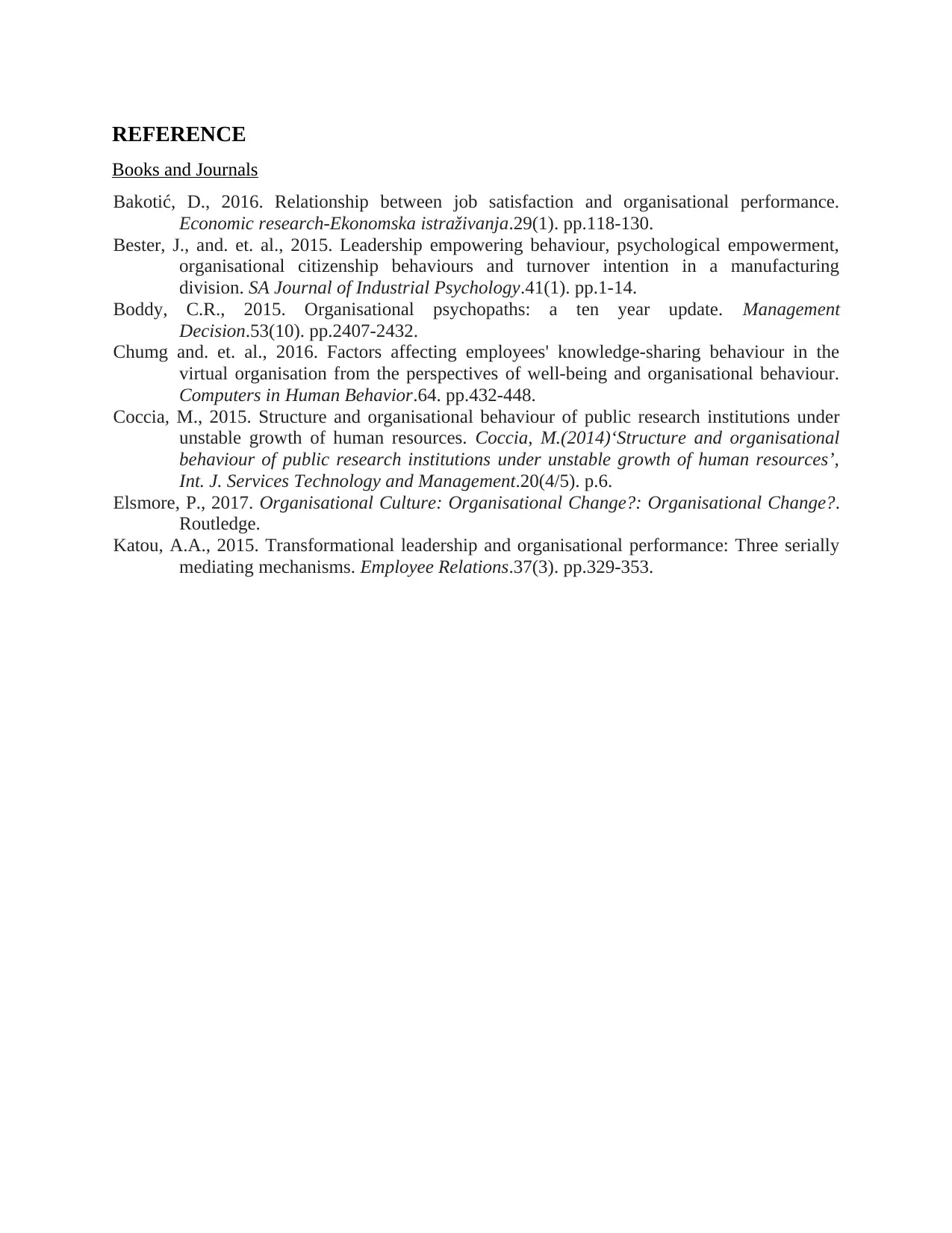
REFERENCE
Books and Journals
Bakotić, D., 2016. Relationship between job satisfaction and organisational performance.
Economic research-Ekonomska istraživanja.29(1). pp.118-130.
Bester, J., and. et. al., 2015. Leadership empowering behaviour, psychological empowerment,
organisational citizenship behaviours and turnover intention in a manufacturing
division. SA Journal of Industrial Psychology.41(1). pp.1-14.
Boddy, C.R., 2015. Organisational psychopaths: a ten year update. Management
Decision.53(10). pp.2407-2432.
Chumg and. et. al., 2016. Factors affecting employees' knowledge-sharing behaviour in the
virtual organisation from the perspectives of well-being and organisational behaviour.
Computers in Human Behavior.64. pp.432-448.
Coccia, M., 2015. Structure and organisational behaviour of public research institutions under
unstable growth of human resources. Coccia, M.(2014)‘Structure and organisational
behaviour of public research institutions under unstable growth of human resources’,
Int. J. Services Technology and Management.20(4/5). p.6.
Elsmore, P., 2017. Organisational Culture: Organisational Change?: Organisational Change?.
Routledge.
Katou, A.A., 2015. Transformational leadership and organisational performance: Three serially
mediating mechanisms. Employee Relations.37(3). pp.329-353.
Books and Journals
Bakotić, D., 2016. Relationship between job satisfaction and organisational performance.
Economic research-Ekonomska istraživanja.29(1). pp.118-130.
Bester, J., and. et. al., 2015. Leadership empowering behaviour, psychological empowerment,
organisational citizenship behaviours and turnover intention in a manufacturing
division. SA Journal of Industrial Psychology.41(1). pp.1-14.
Boddy, C.R., 2015. Organisational psychopaths: a ten year update. Management
Decision.53(10). pp.2407-2432.
Chumg and. et. al., 2016. Factors affecting employees' knowledge-sharing behaviour in the
virtual organisation from the perspectives of well-being and organisational behaviour.
Computers in Human Behavior.64. pp.432-448.
Coccia, M., 2015. Structure and organisational behaviour of public research institutions under
unstable growth of human resources. Coccia, M.(2014)‘Structure and organisational
behaviour of public research institutions under unstable growth of human resources’,
Int. J. Services Technology and Management.20(4/5). p.6.
Elsmore, P., 2017. Organisational Culture: Organisational Change?: Organisational Change?.
Routledge.
Katou, A.A., 2015. Transformational leadership and organisational performance: Three serially
mediating mechanisms. Employee Relations.37(3). pp.329-353.
1 out of 8
Related Documents
Your All-in-One AI-Powered Toolkit for Academic Success.
+13062052269
info@desklib.com
Available 24*7 on WhatsApp / Email
![[object Object]](/_next/static/media/star-bottom.7253800d.svg)
Unlock your academic potential
Copyright © 2020–2025 A2Z Services. All Rights Reserved. Developed and managed by ZUCOL.





